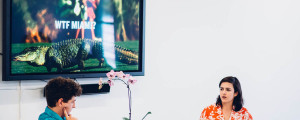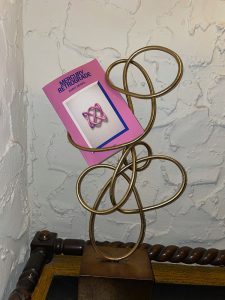
There’s the usual sense of video-call deja vu, when logging on to talk with Emily Segal across time zones. Nearly every social encounter this year in London lockdown has been prefaced by a prompt to “Join with Computer Audio,” and so the cues between a meeting, an interview or just catching up are collapsed into a general feeling of sameness. As the chat progresses though, the conversation soon feels like a reflective pause on this strange present, explored through the themes raised in the LA-based writer and artist’s debut novel, Mercury Retrograde, published in November last year. A fictionalised recollection of Segal’s own experiences navigating the contemporary art and corporate worlds of early 2010s New York, the book reads like a time capsule for a now hermetically-sealed era, a sociological study into pre-COVID culture.
Mercury Retrograde is not, as its title implies, related strictly to astrology, but rather uses Segal’s autofiction as an inroad into contemporary scene-wide currents; the memes, the magical thinking in today’s society, of which the popular pseudoscientific practice is a topical part. Published via Segal’s own independent press Deluge, the book follows an imagined account of the author—fresh from the crossover success of a trend forecasting art collective—taking up a job in an ambiguous internet start-up. She first accepts the role as a social experiment of sorts, going on to detail the meme-conscious hubris of her tech bro employers, along with their immaterial product.

In real life, Segal did in fact emerge in the early 2010s as a member of the K-HOLE trend forecasting art collective, readily associated with a fervour around the ‘post-internet’ scene and the artworld’s flattened mediascape. Famously, the group coined the term ‘normcore’, which took on a memeified life of its own beyond their initial trend reports. Segal has since co-founded the design consultancy and creative direction research group Nemesis, with Martti Kalliala (of Amnesia Scanner) who, alongside advising brands, are known for their more speculative ‘memos’ on trends in consumer culture.
“I don’t think that the future is knowable. I fundamentally don’t,” Segal notes, when asked about the rationalised cause-and-effect-thinking of forecasting. “But I do think it’s possible to articulate emergent phenomena and put together a case for why something may or may not be likely to happen. It’s very similar to criticism in that way, it just has different targets and a different audience, and the vocabulary is different.” Through this articulation of the notion of communication being a shared trait across disciplines, it becomes easier to understand that the interlinked nodes in Segal’s practice are at their core about sociality and subculture.

**I get a sense of interest in your work in the social histories or sociality of corporate culture. So this got me thinking around this idea of the long 1960s: how expressive individualism, counterculture and the ‘68 rebellion have cast this long shadow on business management practices, advertising and, of course, Silicon Valley. Do you think we might finally be shifting away from this cult of individualism?
Emily Segal: My first impulse is a desire to see it shift, and then some pessimism about whether that’s actually happening. I do think that there are some signals that point to a new collectivism, and definitely the way that the internet is shifting seems to point in that direction. I also think that this momentary return to excitement around decentralised web technologies and blockchain also speaks to that in some way. But it’s kind of like what we’re watching getting played out right now: there’s one step in that direction and then Elon Musk’s involvement is so retro, and 20th century, and not actually progressive. So I’m reluctant to say that we’re actually going there. But I do see some signals that new relationships to the collective or the group, or the hive do seem to be emerging.
I started having dreams about Coinbase after I finally bought crypto. I didn’t buy that much of it, I bought a little bit of it, and I instantly started dreaming about it; it made me feel in a very weird, slutty way connected to all the other people who held these currencies. That’s actually something that I think I don’t like about it but I find very interesting. A close friend of mine that was really into the GameStop speculation also was feeling very networked with all the other people that were in on that. I do think there’s something subtle in the way that these types of speculative internet moments sort of bundle together outcomes for a huge group of people, and that probably has some interesting psychological significance.

**I’m glad you brought up GameStop. You mentioned briefly in the book this idea of ‘chaos magic’, an esoteric practice around the power of belief. With that in mind, and the importance in some of your work on memes, I wanted to ask what your thoughts are on ‘meme magic’, obviously in relation to the election of Trump, but more recently GameStop.
ES: Right, there was the interest in meme magic around [the satirical religion] Kek in 2016, and that was fascinating and disturbing to me, given the final K-HOLE trend report was about chaos magic. Hilariously The Guardian reported that K-HOLE invented chaos magic. Which, we didn’t. And yes, there’s been this resurgence of interest in that as a lens for understanding what’s going on. It makes me think of the CCRU [Cybernetic Culture Research Unit] and the idea of ‘hyperstition’ very much, a belief that makes itself true.
I am fascinated in how tacky and commercial chaos magic is, as an occult and pop cultural strand. It does resonate with me as a way of thinking about probability in the vast Instagram mall of our lives. In a certain way, it might help people think about magic in a more expansive way, which is more like making these interventions that may be artistic or ritual in order to affect probabilistic outcomes. Which is a definition of magic that I fuck with. But it doesn’t even need to be in a magical framework; like the CCRU’s hyperstition framework is semi-magical but isn’t coming from a magical perspective as I understand it.
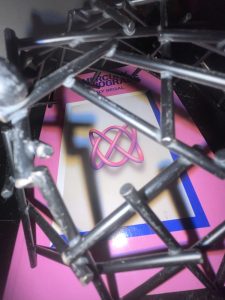
**I wanted to talk a bit about branding and logos. Do you think the power of the logo—like the iconic Nike swoosh etcetera—is evolving more into this idea of consuming style rather than brands? I had this thought of people on Depop selling things that aren’t necessarily a big brand name but rather look like a certain thing. Or even the Chinese internet and Alibaba. Is there loss of ‘aura’ around the ‘authentic’ branded luxury item?
ES: The shift you’re picking up on I’ve also picked up on. It’s to do with this disintermediation that we’ve seen across many different disciplines and industries. So like, Barneys is closed, Opening Ceremony is closed, Century 21 is closed. Now it’s like the factory ‘brands’, the factory lines that were always getting produced and then got different labels sewn onto them, and were put in the marketplace through a particular procedure, are just being sold directly to consumers. That does change the relationship among brands and publics very much.
I think that we’re in a very weird moment where things are just unbundled and out there. I mean, you’re also seeing that with the Substack thing, where instead of reading a particular publication you’re consuming post by post, writer by writer, or podcast by podcast. Everything is unbundled and being consumed in this piecemeal fashion. I think that the function of the logo was very Modernist in terms of trying to establish a coherence among things that were not actually coherent.
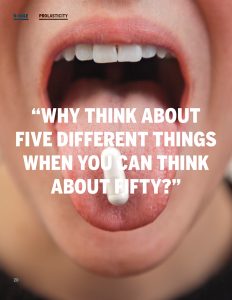
I do think that the Chanel C’s still shine or whatever; I don’t think they’ve been totally desanguinated, or all luxury logos don’t have significance anymore but you’re right it’s not playing the same role that it did for decades. What it makes me think of is this big stack of research that I’ve been doing on the swastika—as sort of the problematic logo par excellence—and then I just sort of felt like it wasn’t that big of a deal. If you were going to be talking about the iconography of white supremacy in this time, the swastika is just not the point. It’s much more interesting to talk about the semiotics of the Boogaloo Boys than to talk about how this holy Eastern symbol got appropriated and morphed into this other thing.
I do think that there will be some shift because of the decision fatigue that comes from consuming everything piecemeal. I don’t think that there’s an inexhaustible appetite for that, and we’ll see what sort of institutions, or platforms, or intermediaries that do feel more current and more relevant are.
**In trend forecasting, at least to me, there’s an implication of a linearity, or cause and effect. This speaks to our culture-wide fixation on the future; this Modernist idea of linear progress and thinking forward. There’s a lot of talk lately about our inability now in imagining the future, and the kind of crisis that puts us in. What are your thoughts on this?
ES: It’s funny, I’m actually much more interested in what people think is going to happen in the future than I have been for many years. So many things have broken down and so many variables are in play, it’s fascinating to see how people are putting those puzzle pieces together and what conclusions they’re drawing.
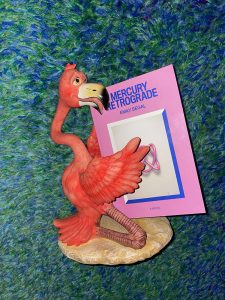
‘Trend forecasting’ as a discipline is very much influenced by the need for a performance of futurity in a corporate setting. Then in particular industries, like fashion, a company like WGSN would in theory have a big effect on essentially commodities futures. Because if they said, ‘oh turquoise is going to be the colour in 15 years’, it might affect the money that [luxury goods conglomerate] LVMH would want to put into buying a certain type of material. There’s a relationship to particular economies around particular industries that then influence what we thought of as trend forecasting as this more expansive ‘humanities lite’ kind of discipline. I’ve always taken it with a grain of salt, or a boulder of salt and a big wink, or a laugh, because I don’t think that the future is knowable.
If it’s possible to be an intellectual who can regard an art object and say, ‘this is what I think is interesting and not interesting about this, and this where I think it came from, and this is what effect it might have on the landscape’—you could certainly do that about a sandal, or an app. Thinking critically through objects is something that I find worthwhile, and trend forecasting invited me to look more expansively at the field of objects I saw as relevant to my inquiry. I appreciate that about it but it definitely gives me the heebie jeebies when people are very serious about it, just because it’s so ridiculous.
The most interesting trend forecasters that I know—or people that I’ve come into contact with that are operating in that modality… nobody actually thinks that history operates in this linear cause-and-effect way, and that we as trend forecasters have some privileged ability to access that. I think only stooges really would think that. It’s a way of articulating multi-variable cultural analysis, basically. It’s kind of cool that it exists but it definitely should be looked at with the same amount of humour, curiosity and skepticism as any other piece of writing I guess.
**Do you have any thoughts about the future of drugs? It’s something that was mentioned briefly in your last Nemesis memo and I think really poignant with the pandemic.
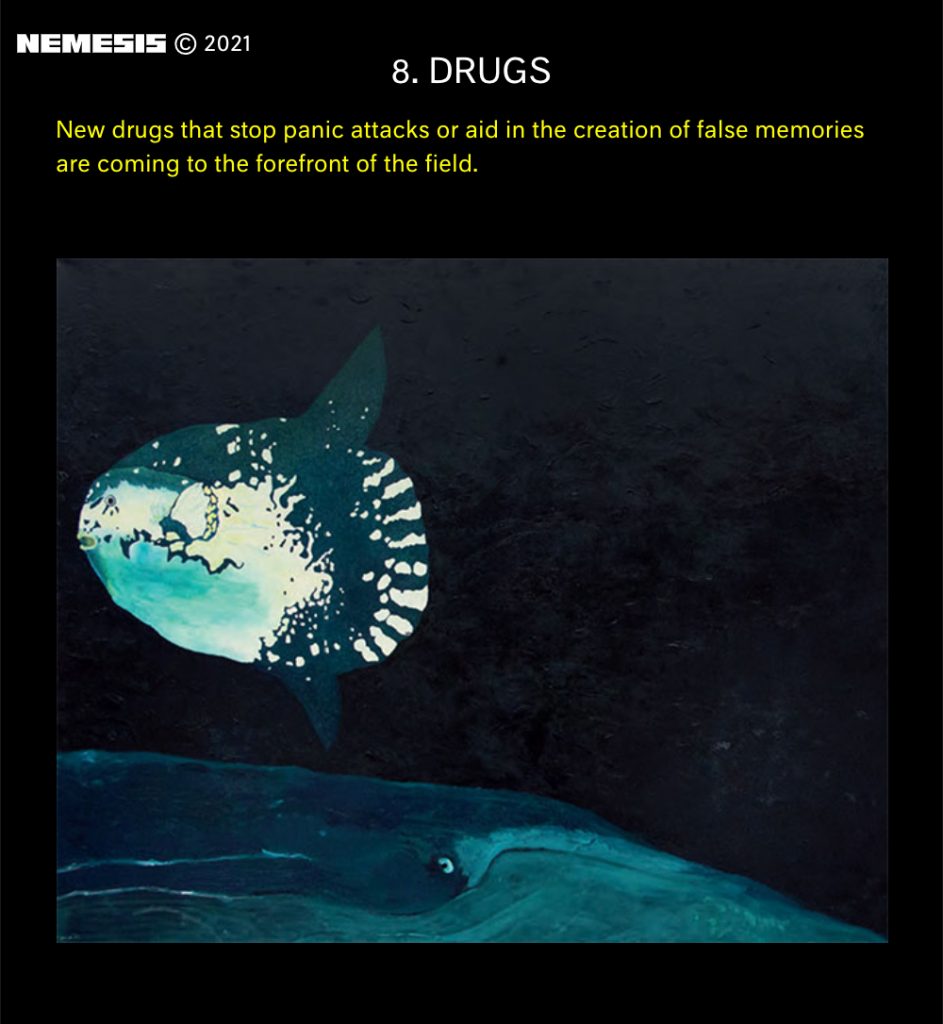
ES: Mass psychedelics are all but a given. There’s a huge commercial frenzy around psychedelics in advance of clinical applications, and new investment funds, and also people who are rightly worried about things like mushrooms being subjected to the same wack corporate treatment as weed. Which was just not very enlightened, not very aesthetically-advanced, not that cool, etcetera. Not evenly applied so not necessarily benefiting the people that have worked with this stuff for ages.
One thing that comes to mind is I’ve just read this book called Drug Use for Grown-Ups by Carl Hart, which I think is really fascinating and I recommend. It’s sort of like a polemic that is on the liberatarian side of things, but also has a very strong anti-racist perspective. Carl Hart has been a scientist studying the effects of drugs for decades and has worked on drug policy internationally forever. He comes out in this book as a casual drug user and talks about his own heroin use, and talks about drugs that are considered to be the most dangerous and not okay, and basically calls bullshit on what everyone thinks about them, and says that the cultural significance of drugs is totally out of sync with the chemical and personal significance of drugs to most people. It’s a really brave and fascinating book, and has a lot of issues with the way that psychedelics as a class of drugs are de-stigmatised relative to other classes of drugs. It’s like, because this drug is ‘spiritual medicine’ it’s okay, but if people want to get high on speed they’re trash. It reinforces a certain class difference, or it’s just pretentious.
I definitely see a strong new anti-psychiatry movement brewing. I mean, I think it would be amazing to see widespread decriminalisation and/or legalisation of drugs, and it feels more possible to me than it might have a few years ago, but I don’t think it’s going to happen anytime soon. And then we’ll see if there are a lot more designer drugs that people start doing. That’s one of the things that I think is so weird, how few designer drugs become popular, because in a way you’d think that they’d be as normal as a new pop song.

**You’ve had this interesting involvement in the artworld through K-HOLE several years ago. I wanted to ask how you think contemporary art’s place in the world might have shifted since that time—its relation to popular culture and the market—especially after the pandemic. I spoke with Elvia Wilk on our podcast and we had this interesting chat on what the pandemic’s done to the artworld’s cosmopolitanism. What are your thoughts on some of these ideas?
ES: The first K-HOLE report came out in May of 2011, so it’s approaching 10 years ago, which is crazy. At the time, we were in a post-2008 collapse scenario in which the academy was in trouble, publishing was collapsing, and the artworld managed to absorb a lot of multidisciplinary and intellectual activity that couldn’t find support in other areas. It was doing it in a way that had this global cosmopolitan thing happening, and a relationship to a lot of freely-flowing money. Although over the years, of course, we all learnt how dark and messed up a lot of those capital flows were. You know, it had something to offer to people who were not necessarily finding a home in the disciplines that they were supposed to be finding them.
Up through the ‘post-internet’ movement, or moment—to call it a movement sounds kind of ridiculous ‘tbh’—but there was this thing going that was like ‘X but art’. A juice bar but it was art, or making podcasts but it was art, and all these artist-run projects happening in various media could be both what they were and art. K-HOLE was working with that gesture, as well, or that tension. Artists making a trend report that both is a trend report and it’s an art object. What we were doing was both a business and a conceptual gesture.
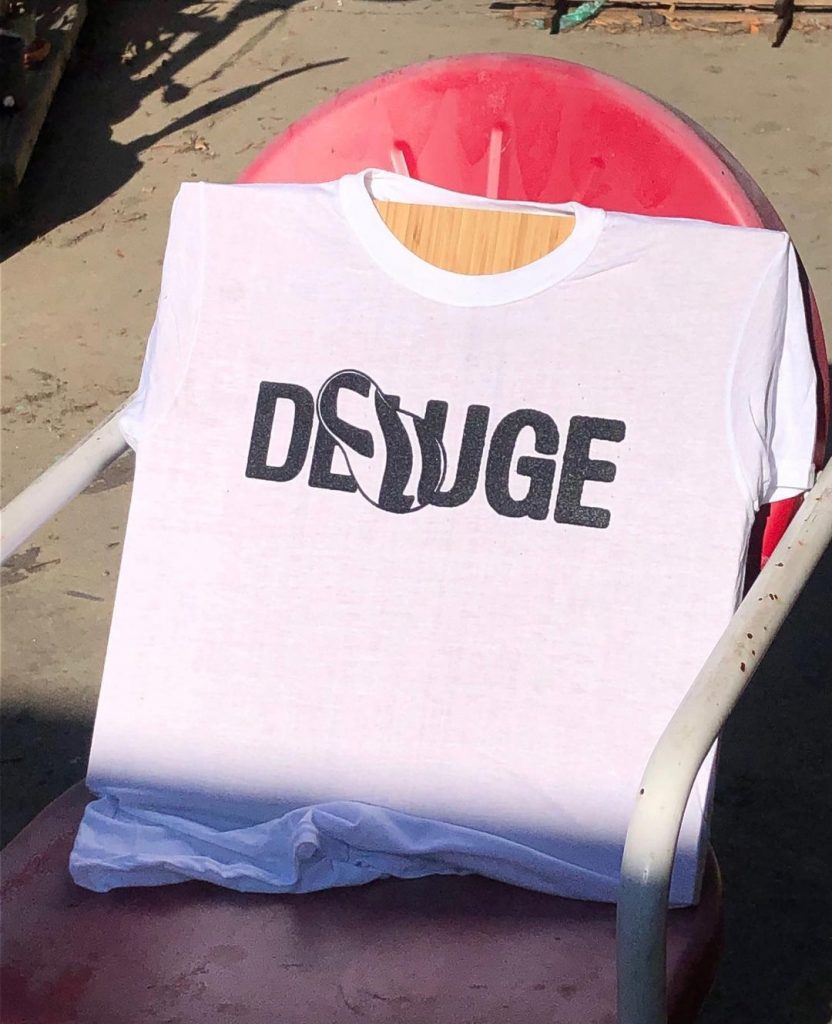
Now I see a lot of those practices unbundling; it’s like what we were talking about with the disintermediation. Deluge, that I started, is an artist-run press but it doesn’t need to be an artwork, it can just be a press and function. Whereas in the 2010s, I think there was this calculus going on where it was like interesting, or situationally relevant to contextualise certain things as art. Now I think we’re returning to art as a product that can be bought and sold. It doesn’t have to be that grim, I don’t think. It’s just that a lot of this extraneous intellectualising that was going on in the artworld—because it didn’t have a place elsewhere—is now just finding its own platforms and doing its own things, and the artworld needs to figure out how to buy and contextualise ‘actual’ art objects.
I don’t think we’re going back to what we knew as a sort of cosmopolitan art world but I think that’s kind of good. I’ve enjoyed thinking through my own activities as part of an art practice, and I do see what I do as an art practice, but I’m also fine with it not being this heavy-handed thing, where you have to call everything art in order for it to be valid. I was voted ‘Most Pretentious’ in my high school yearbook and ‘Biggest Indie Snob’, so I think that I loved calling everything that I did art. In a certain way, I still believe that, but it’s also fine for people to just think whatever they want about everything that I do.**
Emily Segal’s Mercury Retrograde was published via Los Angeles’ Deluge Books in November, 2020.

